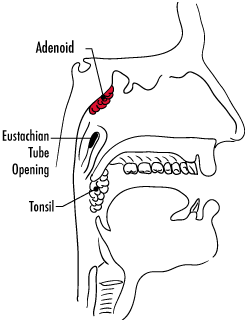Adenoidectomy
Article Translations: (Spanish) (Hmong) (Somali)
What are adenoids?
The adenoid is a single mass of tissue located way in the back of the nose where the nose joins the throat. (Although most people say "adenoids" as if there is more one, we really have just one adenoid.)
The adenoid is part of our immune system. Our immune system helps us fight germs that cause illness. The adenoid however, is only a very small part of our immune system. Children who have their adenoid (and even the tonsils) removed do not have more illnesses than children who “keep” their adenoid. In fact, some children will get fewer illnesses, like recurrent nasal infections, after their adenoid is taken out.

Why does my child need their adenoid removed?
There are a number of reasons that your provider may recommend removal of your child’s adenoid including:
- To help your child breathe and sleep better. If a child’s adenoid becomes too large, it can partially block a child’s breathing during sleep and this can cause snoring, restless sleep and overall sleep disturbance.
- For frequent ear infections or chronic middle ear fluid. The adenoid is located next to the opening of the Eustachian tube in the back of the nose. The Eustachian tube helps keep the ears healthy. A large adenoid or constantly infected adenoid can lead to swelling or blockage of the Eustachian tube. When the adenoid is removed, ear infections and fluid are less likely to occur.
- For recurrent adenoid infections. Some children have recurrent nasal infections with thick, green or yellow drainage. Sometimes this drainage gets better with antibiotics, but often returns when the antibiotics are stopped; this is a sign of chronic adenoid infection. Removing the adenoid can help this problem, but will not prevent the common cold or illnesses that cause nasal drainage.
How is the adenoid removed?
- Removal of the adenoid is a surgical procedure. This procedure is referred to as adenoidectomy. It is performed by an ears, nose, and throat surgeon in the operating room under general anesthesia. The procedure itself usually takes 20 to 30 minutes.
- Although the adenoid is in the back of the nose, it is removed through the mouth and there are no visible scars after surgery.
- The surgeon can remove most, but not all, of the adenoid tissue. Although it is possible for the adenoid to grow back and cause symptoms again, it is rare for a child to need the adenoid removed a second time.
What can I expect after surgery?
- Children usually go home the same day after surgery, but in some cases your surgeon may recommend keeping your child in the hospital overnight.
- Once your child is ready to be discharged home, they will be instructed to:
- Use Tylenol® (acetaminophen) or Children's Motrin® (ibuprofen) as needed for pain management.
- Your child can eat their normal diet as tolerated.
- Encourage your child to drink plenty of fluids. This keeps the throat moist and helps with discomfort as well as helps to prevent dehydration.
- Your child may return to regular activities following surgery
- Your child may return to school/daycare when they are feeling well and not requiring regular pain medications. Most children return to school/daycare within 1-3 days.
- Common symptoms after surgery:
- An upset stomach and possible vomiting in the first 24 hours after surgery
- Increased nasal congestion, snoring, runny nose, bad breath and neck soreness due to swelling after surgery. These symptoms will go away during the first 3 weeks after surgery.
- Fevers up to 102.0 F are considered normal after surgery. Call your provider for fevers over 102.0 F that do not come down with acetaminophen (Tylenol) and/or Ibuprofen
- Voice may sound different but will improve over 6-8 weeks
- Ear pain. This is actually pain from the adenoid area – not the ear!
- Streaks or speckles of blood in nasal mucus or saliva are common during the first few hours and not worrisome
- Severe bleeding is rare after adenoidectomy. If your child coughs up, throws up, or spits out bright red blood or blood clots, bring him/her to a Children’s Emergency Room immediately.
- If you are concerned about dehydration (sunken eyes, dry and sticky lips, no urine for over 8 hours, and no tears) call the ENT clinic.
Questions?
The information provided in this brochure is not specific to your child. This information is provided as a service to our patients. The information is for educational and informational purposes only and should NOT be used as a substitute for the advice of your child’s physician. If you have any questions, please call Children’s ENT & Facial Plastic Surgery at 612-874-1292.
Reviewed 10/2022
This page is not specific to your child, but provides general information on the topic above. If you have any questions, please call your clinic. For more reading material about this and other health topics, please call or visit Children's Minnesota Family Resource Center library, or visit www.childrensmn.org/educationmaterials.
© 2024 Children's Minnesota
